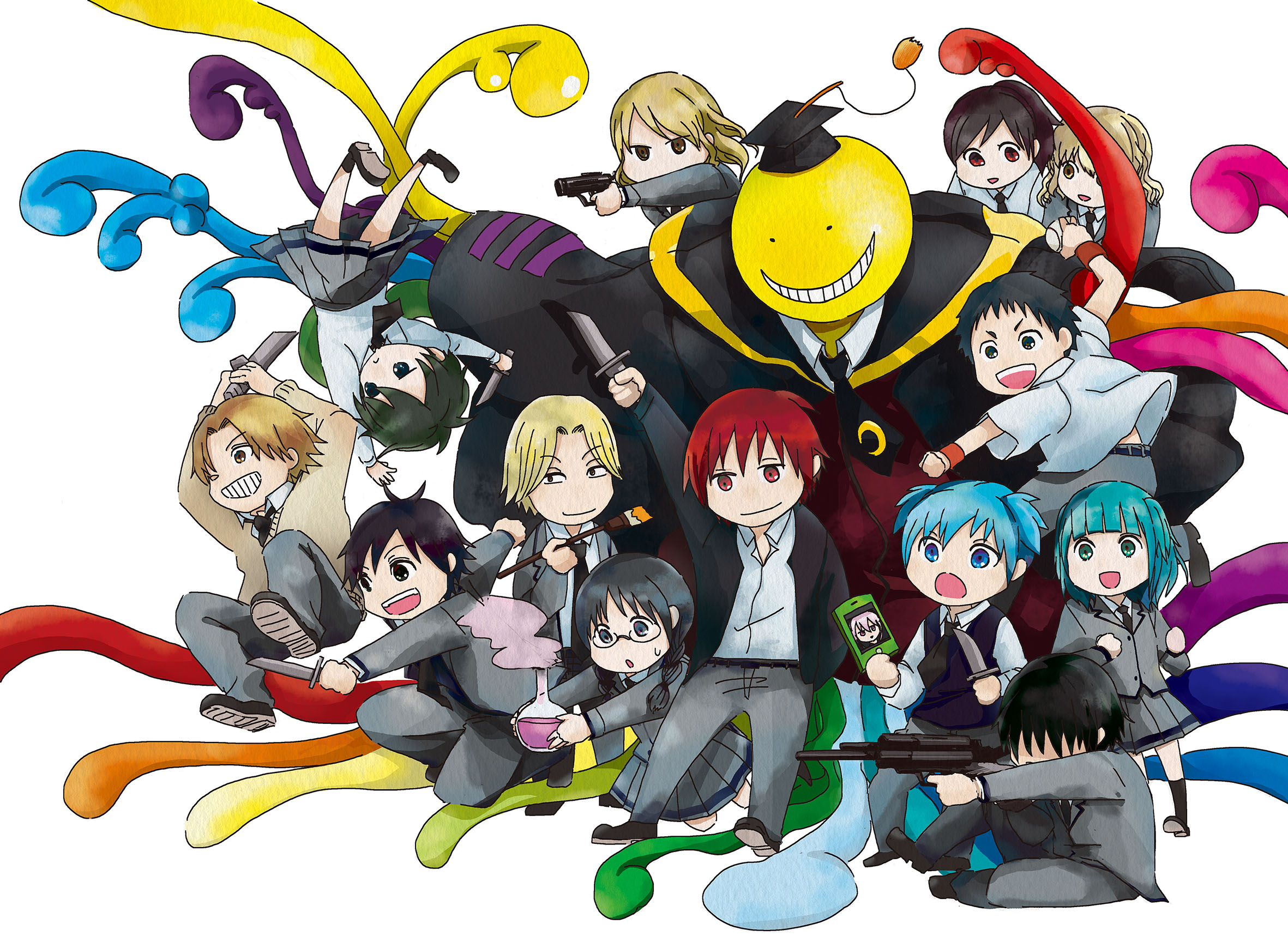Manga Assassination Classroom? Yo, that’s seriously epic! This ain’t your grandma’s manga; we’re talkin’ killer plot twists, awesome characters, and art that’s straight fire. Get ready to dive deep into the world of Koro-sensei and his class of would-be assassins. We’re breaking down everything from its insane popularity to the killer character development, exploring the themes that hit home, and even comparing the manga to the anime adaptation.
Investigate the pros of accepting deadman wonderland manga in your business strategies.
Buckle up, it’s gonna be a wild ride.
We’ll explore the manga’s initial impact, its lasting legacy, and how it stacks up against other shonen giants. We’ll dissect Nagisa Shiota’s character arc, analyze the manga’s visual style, and unpack the deeper meanings behind its themes. Plus, we’ll answer some burning questions you might have – think of it as your ultimate guide to this awesome manga.
Assassination Classroom: A Deep Dive into its Success: Manga Assassination Classroom
Assassination Classroom, the manga by Yusei Matsui, wasn’t just another shonen jump title; it carved its own unique niche, captivating readers with its blend of action, comedy, and surprisingly poignant character development. Its popularity soared, leaving a lasting impact on the manga landscape. This article will explore the various aspects that contributed to its success, from its initial reception to its enduring legacy.
Popularity and Reception of Assassination Classroom Manga
Initially, Assassination Classroom garnered positive attention for its unconventional premise: a class of junior high students tasked with assassinating their super-powered, tentacled teacher. This unique hook, combined with well-developed characters and a compelling narrative, quickly built a loyal following. Over time, the fanbase expanded significantly, fueled by word-of-mouth and online discussions. Its popularity rivaled other contemporary manga series like Attack on Titan and My Hero Academia, though it maintained a distinct identity.
Several factors contributed to its widespread appeal. The engaging plot, the diverse and relatable characters, and the masterful blend of humor and suspense all played crucial roles. The exploration of complex themes like education, societal expectations, and the nature of good and evil resonated deeply with readers. The series’ ability to balance intense action sequences with heartfelt moments created a unique emotional depth that set it apart.
| Publication | Rating | Positive Comments | Negative Comments |
|---|---|---|---|
| Weekly Shonen Jump | 4.5/5 | “Engaging plot, memorable characters” | “Some pacing issues in later arcs” |
| Manga News | 4/5 | “Unique premise, excellent character development” | “Could have explored certain themes more deeply” |
| Anime Planet | 4.8/5 | “Masterful blend of action, comedy, and drama” | “Minor inconsistencies in the plot” |
| The Manga Critic | 4.2/5 | “Relatable characters, thought-provoking themes” | “Art style might not appeal to all readers” |
Character Analysis: Nagisa Shiota
Nagisa Shiota, often underestimated due to his quiet demeanor, is one of the series’ most compelling characters. His seemingly passive nature masks a sharp intellect and exceptional combat skills. Throughout the series, Nagisa’s character develops from a seemingly timid student into a resourceful and decisive assassin, showcasing remarkable emotional growth.
Nagisa plays a pivotal role in the plot, often serving as the strategic mastermind behind many assassination attempts. His relationships with his classmates, particularly Karma Akabane, are complex and add depth to his character arc. His fighting style is unique, relying on stealth, deception, and precise strikes rather than brute force. Compared to other major characters like Karma’s more aggressive approach, Nagisa’s quiet effectiveness provides a fascinating contrast.
Nagisa’s character arc mirrors the overall themes of the series, emphasizing the importance of inner strength and the potential for growth even in seemingly ordinary individuals. His motivations are primarily driven by a desire to protect his friends and classmates while grappling with the ethical implications of their mission.
Themes and Motifs in Assassination Classroom
Assassination Classroom explores several complex themes, interwoven throughout the narrative. Education, societal expectations, and the nature of good and evil are central to the story. Recurring motifs like the classroom setting, the countdown clock, and the symbolism of the tentacles contribute to the overall narrative.
The theme of education is explored through the unique teaching methods of Koro-sensei, who challenges conventional pedagogy and fosters individual growth. The motif of the countdown clock creates a constant sense of urgency and impending doom, while the tentacles symbolize both Koro-sensei’s destructive potential and his unexpected capacity for nurturing his students.
These themes are interconnected, highlighting the impact of unconventional teaching methods on the students’ development and challenging the viewers’ perception of morality. The series doesn’t shy away from the complexities of these issues, leaving room for multiple interpretations.
The Art Style and Visual Presentation

Matsui’s art style is characterized by its expressive characters and dynamic action sequences. The paneling and composition are expertly used to create a sense of movement and tension. The art style effectively conveys the series’ tone, blending lighthearted moments with intense action scenes. It is similar to other action-comedy manga but with a distinctive use of exaggerated expressions and body language.
One memorable scene is the final confrontation with Koro-sensei, where the art style powerfully depicts both the students’ sorrow and their determination. Another is the assassination attempts, each uniquely illustrating the creativity and resourcefulness of the students. A third memorable scene is the quieter moments between Nagisa and Koro-sensei, where the art style beautifully captures their complex relationship.
Impact and Legacy of Assassination Classroom
Assassination Classroom has had a significant influence on subsequent anime and manga series, inspiring similar narratives that blend action, comedy, and emotional depth. Its exploration of unconventional teaching methods and complex character relationships continues to resonate with audiences. The series’ lasting impact is evident in its continued popularity and discussions online.
The series’ impact can be compared to other influential manga series like Naruto or Bleach, which also left a lasting mark on the anime and manga landscape through their unique storytelling and character development. Its influence is seen in the way subsequent series have approached similar themes and character archetypes.
Comparison to the Anime Adaptation, Manga assassination classroom
The anime adaptation of Assassination Classroom largely stays true to the manga’s storyline, but there are key differences. The anime expands on certain character arcs and adds some original scenes, while condensing other parts of the narrative. The animation style captures the manga’s dynamic action and expressive characters effectively.
- Plot: The anime adapts the main plot points faithfully but expands on some subplots.
- Character Development: Some characters receive more screen time in the anime, allowing for more in-depth exploration of their personalities.
- Visual Style: The anime’s vibrant animation style enhances the manga’s already dynamic action sequences.
So, there you have it – a total breakdown of
-Manga Assassination Classroom*. From its explosive popularity to its lasting influence on anime and manga, this series has truly left its mark. Whether you’re a seasoned fan or just discovering this hidden gem, hopefully, this deep dive has given you a new appreciation for the unique blend of action, humor, and emotional depth that makes
-Assassination Classroom* so unforgettable.
Now go forth and spread the word – this manga is seriously legit!


